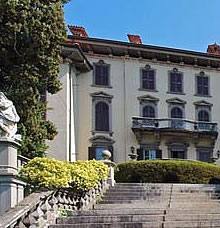
- GOLF
- VILLE E PALAZZI
- PARCHI, RISERVE NATURALI, ORRIDI
attraction Verbania
Villa San Remigio
Villa San Remigio, which is bordered by the homonymous little 12th-century church after which it was named, rises on the Castagnola hills in Pallanza, north of the gardens at Villa Taranto, in a charming position with a marvellous view of Lake Maggiore. The building is surrounded by a luxuriant meadow full of flowers, majestic trees, rare essences and pleasant corners brought to life with ancient sculptures and precious decorations and ornaments.
The villa (which dates back to the early 20th century) has a charming romantic history. It was built to embody the love between Neapolitan poet and musician Marquis Silvio della Valle di Casanova and Irish artist Sofia Browne. The coupled wanted to realise their childhood dream by transforming the old chalet built by the grandfather, into a villa and creating a place in the park where art and nature could merge freely into one single harmonious solution.
The park at Villa San Remigio
Embellished with lawned terraces bordered by exotic species, the park has diverse areas capable of summarising the history of the gardens over time. The medieval garden has room for an orchard amidst breathtaking views of the lake, flights of steps and narrow passages leading to gardens delle Ore, a pleasant reminder of the time transpire, della Letizia, a joyous homage to happiness, della Mestizia, whose shadows attract melancholy, delle Memorie, an emblem of nostalgia for time passed and finally dei Sospiri, home to a mosaic exedra with seven niches decorated with the statues of mythological goddesses.
The Hortus Conclusus in the little Church of San Remigio is a secluded, silent area that inspires meditation. The park was created in 6 years (1910-1916), thanks to the skilful work of 30 gardeners. Later, the owners decided to open the gates to the public (only on scheduled days and for a fee) and profits were given to charity. This praiseworthy initiative lasted until 1929. The gardens can now be visited on weekends in the spring and summer and include a guided tour (approximately 2 hours).
Villa San Remigio: the building
The façades are in Lombard baroque style as indicated by the large cornice and windows under triangular and curvilinear tympanums. The villa’s balconies stand out: running north-east and south-east, they are upheld by a rock tunnel with portico whose function is a winter garden. The building’s layout is articulated and characterised by large halls decorated with portals, cornices, fireplaces, wooden ceilings and rich furniture. It is currently the seat of the Province of Verbano-Cusio-Ossola. The weapons and music halls are the most important ones (civil weddings are often celebrated here). The gothic hall and humanist study are around the main hall.
There are 3 other buildings worth mentioning in the complex of Villa San Remigio: the art study built in 1896 in medieval-like style, the stables, and the 18th-century porter’s lodge and family chapel built in 1898 on the cliff. Among others, illustrious guests at the villa included Gabriele D’Annunzio and futurist artist Umberto Boccioni, whose last paintings portray scenes of the lake. Civil weddings are performed in the villa. Contact the Municipality of Verbania for information.
Photo gallery Villa San Remigio






Follow @LagoMaggioreNet